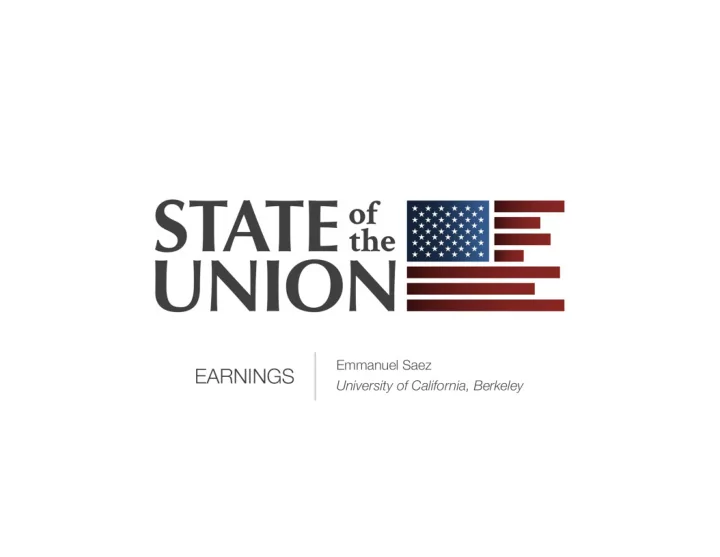

Gender Inequality: Earnings 2018 State of the Union Emmanuel Saez UC Berkeley 1
TRADITIONAL WAGE GENDER GAP Inequality in earnings between men and women is a key aspect of gender gap Large literature documenting gender earnings gap across time and countries Most widely used statistic is the ratio of female to male median wages among workers This ratio is typically estimated with survey data (Current Population Survey in the US) In the US, ratio was 62% in 1973, 76% in 1993, and 81% in 2015 2
COMPREHENSIVE EARNINGS GAP Traditional wage gender gap captures only fraction of total gap in earnings 1) Women less likely to work than men or work fewer hours 2) Wage does not include fringe benefits or self-employment 3) Median does not capture the top of the distribution In Piketty, Saez, Zucman QJE’18, we compute comprehen- sive measures of the earnings gender gap combining tax data, survey data, and national accounts Earnings = wages earnings + payroll taxes + fringe benefits + self-employment income Comprehensive measure of labor income 3
Gender Gap in Earnings: Men to Women ratio 400% 350% average pre-tax labor income of men aged 20-64 to women aged 20-64 300% 250% 200% 150% 100% 1962 1966 1970 1974 1978 1982 1986 1990 1994 1998 2002 2006 2010 2014
Gender Gap in Earnings: Men to Women ratio 400% average pre-tax labor income of men 350% aged 20-64 to women aged 20-64 300% median weekly wages of men to women (among full time workers) 250% 200% 150% 100% 1962 1966 1970 1974 1978 1982 1986 1990 1994 1998 2002 2006 2010 2014
Median pre-tax labor income: working-age men vs. working-age women 45,000 40,000 Real median pre-tax income ($2014) Working-age men 35,000 30,000 Working age adults 25,000 20,000 15,000 Working-age women 10,000 5,000 0 1962 1966 1970 1974 1978 1982 1986 1990 1994 1998 2002 2006 2010 2014 Source: Appendix Table II-B13.
Share of women in the employed population 50% 40% 30% 20% 10% 0% 1962 1966 1970 1974 1978 1982 1986 1990 1994 1998 2002 2006 2010 2014 Source: Appendix Table II-F1.
Share of women in the employed population, by fractile of labor income 50% 45% 40% 35% All 30% Top 10% 25% 20% Top 1% 15% 10% Top 0.1% 5% 0% 1962 1966 1970 1974 1978 1982 1986 1990 1994 1998 2002 2006 2010 2014 Source: Appendix Table II-F1.
CONCLUSIONS Comprehensive gender gap in earnings much larger than tra- ditional median wage gap Comprehensive gender gap has shrunk a lot in the US but pace of convergence has slowed down Substantial gender gaps remain at the top of the distribution Gender gap evolution is a fascinating laboratory to understand determinants of pay inequality ⇒ Clearest evidence that social norms, work regulations, poli- cies a ff ect relative power and shape pay disparity ⇒ Economic model (pay = marginal product) too narrow 9
Recommend
More recommend